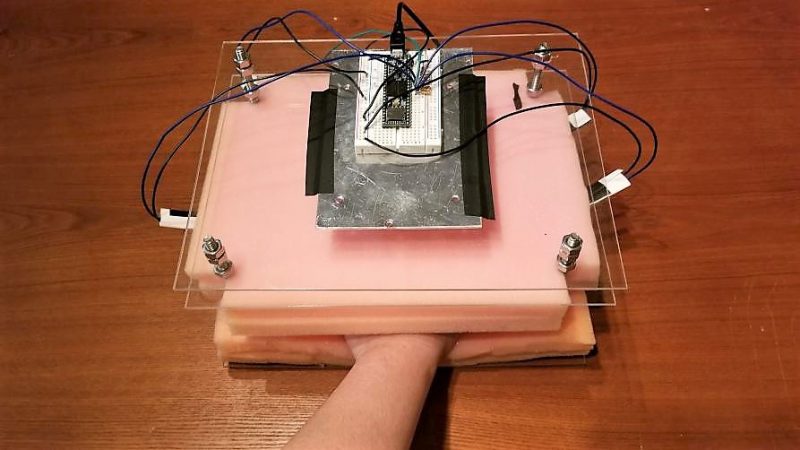Consider the complexity of the appendages sitting at the end of your arms. The human hands contain over a quarter of the entire complement of bones in the body, use dozens of muscles both in the hand itself and extending up the forearm, and are capable of almost infinite variance in the movements they can create. They are exquisite machines.
And yet when it comes to virtual reality, most simulations treat the hands like inert blobs. That may be partly due to their complexity; doing motion capture from so many joints can be computationally challenging. But this pressure-sensitive hand motion capture rig aims to change that. The product of an undergraduate project by [Leslie], [Hunter], and [Matthew], the idea was to provide an economical and effective way to capture gestures for virtual reality simulators, which generally focus on capturing large motions from the whole body.
The sensor consists of a sandwich of polyurethane foam with strain gauge sensors embedded within. The user slips his or her hand into the foam and rests the fingers on the sensors. A Teensy and twenty lines of code translate finger motions within the sandwich into five axes of joystick movement, which is then sent to Unreal Engine, where finger motions were translated to a 3D-model of a hand to play a VR game of “Rock, Paper, Scissors.”
[Leslie] and her colleagues have a way to go on this; testers complained that the flat hand posture was unnatural, and that the foam heated things up quickly. Maybe something more along the lines of these gesture-capturing gloves would work?















I used some flex sensors siliconed to the fingers of a glove to read finger movements. Works great for the more overt movements of bending your fingers but can’t detect if you’re moving them laterally. A set of flex sensors between the fingers might solve that.
“almost infinite” is almost nonsensical.
Fair enough.
https://www.youtube.com/watch?v=s-HAsxt9pV4
Smarter Every Day had a great couple of videos on a really cool implemention of VR gloves which include haptic feedback.
We built a sign language translator device in school with flex sensors on each finger and a mpu on the backhand. I think for capturing the “figure” the hand makes, it is simpler than a big foam setup
I overslept – it’s April 1st already?? Either that or I’ve travelled back in time to 1950 when haptic gloves, potentiometers and load cells didn’t exist…
I agree, in many VR applications and games, the processing level of hand movements is low. But this is the most important control element in the virtual world. Such a simulation is very difficult to implement, so in many cheap virtual reality helmets, it is implemented very bad. More expensive virtual reality helmets have additional controllers which allow users to better interact with an application or a game interface. It would be good if special sensors will be used, that allows to better calculate trajectories of hand movements and make better simulations.